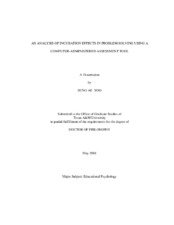| dc.description.abstract | An insightful solution to a problem may be promoted by temporarily being away from the problem at hand and engaging in other tasks or problems. Wallas (1926) conceptualized such an interruption period between problem solving activities as an incubation period. The present study examines the effect of such activities that are provided as an incubation period in computer-based problem solving tasks. In addition, this study explores the potential interaction between the type of problems and the type of interruption tasks involving two types of problems (verbal and spatial) and two types of interruption activities (verbal and spatial). One hundred eighty five undergraduate volunteers participated. The participants were randomly assigned to one of the six conditions, Spatial Problems: No-Interruption Task, Spatial Problems: Verbal Interruption Task, Spatial Problems: Spatial Interruption Task, Verbal Problems (Anagrams): No-Interruption Task, Verbal Problems (Anagrams): Verbal Interruption Task, and Verbal Problems (Anagrams): Spatial Interruption Task. A computerized technique was developed and incorporated for data collection and material presentation. This technique was considered to have advantages over the conventional data collection format because of its ability to (1) standardize the presentation and assessment of problem solving tasks, (2) allow subjects to manipulate the problem components as they desire, simulating real world problem solving approaches, and (3) monitor the subjects’ on-going interactions through the use of intricate, covert, data collection techniques. Regression analyses were employed to analyze the data collected using this computerized technique. The findings from the present study partially support the view that problem solvers can benefit from a temporary interruption task in a problem solving sequence. The participants resolved the problems more quickly when distracted by an intervening simple cognitive task than when allowed to work continuously. It was implied that a problem solver could benefit from an interruption that involves stimuli changing visually and spatially and that also demands some degree of cognitive involvement. Although the present study did not demonstrate effects of interaction between the problem types and interruption types, the findings suggested that in the case of spatial problems, engaging in an incubation activity is likely to result in more efficient performance. | en |


